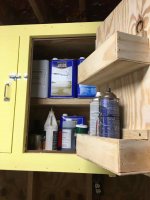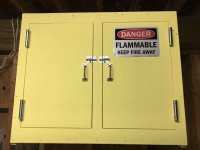I've been putting this project off for a unreasonable amount of time but finally got around to making a proper storage cabinet for my flammable liquids. I originally like probably some of you started looking to purchase one but couldn't get over the prices. I then started looking into all available options and found a Manufacture that produces a line of flammable liquid lockers out of 1" exterior grade plywood that in my nonprofessional opinion provide some benefits over the standard metal flammable liquid locker. Below are NFPA requirements for wooden flammable liquid cabinets:
Wooden cabinets constructed in the following manner shall be acceptable;
a. The bottom, sides, and top shall be constructed of exterior grade plywood that is at least 1 inch (25mm) thick and of a type that will not break down or delaminate under fire conditions.
b. All joints shall be rabbeted and shall be fastened in two directions with wood screws.
c. Where more than one door is used, there shall be a rabbeted overlap of not less than 1 inch 25mm)
d. Doors shall be equipped with a means of latching, and hinges shall be constructed and mounted in such a manner as to not lose their holding capacity when subjected to fire exposure.
e. A raised sill or pan capable of containing a 2 inch (50mm) depth of liquid shall be provided at the bottom of the cabinet to retain spilled liquid within the cabinet.
By being made out of plywood it made it much easier for me to make one myself. I ended up finding two different but similar plans online at Popular Woodworking1 &
Popular Woodworking2. I ultimately purchased the set of Finish Cabinet plans from Popular Woodworking but I've only built the flammable liquid locker and hung it as a upper cabinet in my storage area.
While 1" exterior grade plywood may be readily available in your area after calling a couple of local lumber yards I was only able to find 1 1/8" tongue and groove exterior grade plywood. I bought a couple sheets of it and paid roughly $80 with tax per sheet. One cabinet can be made with one sheet of ply. If I wasn't able to find the 1 1/8" ply I probably would have use 2 sheets of 1/2" ply.
The plans I purchased included a cut list but not a cut layout. With a quick sketch I was able to create a cut layout that worked around cutting off the tongue and groove which was a total width reduction of 2". I didn't have to make any changes to the cut list due to the plywood being a 1/8" thicker other than the rail and stiles were modified after the face frame was constructed.
As usual I stuck to the plans for the first go around except I made the interior shelf a little deeper so that it could hold (2) 1 gallon cans deep. The door boxes are handy and fit your typical short and tall aerosol cans perfectly. All joints were either 1 1/8" dados or rabbets. I secured all joints with epoxy and stainless Spax deck screws from both sides.
I couldn't find 1/4" hardboard so I glued two layers of 1/8" hardboard together. In my opinion I believe that the rail and stiles are the weak point of the cabinet and it would be better to use 1" ply or other substitute but thats my opinion. I'm considering adding a door seal that expands in high temperatures.
The hinges I used are the heavy duty spring type compared to the plans screen door hinges. After using the more expensive hinges I've decided when I make another one I'm going to use cheaper hinges because the heavy duty ones are overkill.
I sanded the outside to 80 grit on the RO setting and the inside to 60 grit on the eccentric rotary mode of the Rotex. I followed that by top coating the exterior with two coats of Benjamin Moore INSL-X Fire Retardant Paint FR-110. My local paint supply was able to order me a gallon of it. The maximum amount of tint they are allowed to add to the paint is 2 oz and since the base is white I was limited to various pastel colors which wasn't the bright yellow I was looking for. Its pastel yellow but I'm not concerned because its shop furniture.
I wasn't able to find a stated "fire rating" for 1 1/8" ply but in of the Popular Woodworking plans they stated its 10 minutes. The linked TDS for the Fire Retardant paint states "Note: 30 minute burn class A rating. ASTM E-84 with
spread rate: 2 coats at 150-165 square feet/gallon (9.5-
10.4 mils WFT and 4.4-4.8 mils DFT each)." Whatever the actual fire rating is I'm just glad to see that I have some form of fire protection for my flammable liquids.
I bought the sign from Mysafetysign.com
Hopefully my post will help someone else looking for a solution to storing their flammable liquids.
Below are a few pictures of the cabinet:
Wooden cabinets constructed in the following manner shall be acceptable;
a. The bottom, sides, and top shall be constructed of exterior grade plywood that is at least 1 inch (25mm) thick and of a type that will not break down or delaminate under fire conditions.
b. All joints shall be rabbeted and shall be fastened in two directions with wood screws.
c. Where more than one door is used, there shall be a rabbeted overlap of not less than 1 inch 25mm)
d. Doors shall be equipped with a means of latching, and hinges shall be constructed and mounted in such a manner as to not lose their holding capacity when subjected to fire exposure.
e. A raised sill or pan capable of containing a 2 inch (50mm) depth of liquid shall be provided at the bottom of the cabinet to retain spilled liquid within the cabinet.
By being made out of plywood it made it much easier for me to make one myself. I ended up finding two different but similar plans online at Popular Woodworking1 &
Popular Woodworking2. I ultimately purchased the set of Finish Cabinet plans from Popular Woodworking but I've only built the flammable liquid locker and hung it as a upper cabinet in my storage area.
While 1" exterior grade plywood may be readily available in your area after calling a couple of local lumber yards I was only able to find 1 1/8" tongue and groove exterior grade plywood. I bought a couple sheets of it and paid roughly $80 with tax per sheet. One cabinet can be made with one sheet of ply. If I wasn't able to find the 1 1/8" ply I probably would have use 2 sheets of 1/2" ply.
The plans I purchased included a cut list but not a cut layout. With a quick sketch I was able to create a cut layout that worked around cutting off the tongue and groove which was a total width reduction of 2". I didn't have to make any changes to the cut list due to the plywood being a 1/8" thicker other than the rail and stiles were modified after the face frame was constructed.
As usual I stuck to the plans for the first go around except I made the interior shelf a little deeper so that it could hold (2) 1 gallon cans deep. The door boxes are handy and fit your typical short and tall aerosol cans perfectly. All joints were either 1 1/8" dados or rabbets. I secured all joints with epoxy and stainless Spax deck screws from both sides.
I couldn't find 1/4" hardboard so I glued two layers of 1/8" hardboard together. In my opinion I believe that the rail and stiles are the weak point of the cabinet and it would be better to use 1" ply or other substitute but thats my opinion. I'm considering adding a door seal that expands in high temperatures.
The hinges I used are the heavy duty spring type compared to the plans screen door hinges. After using the more expensive hinges I've decided when I make another one I'm going to use cheaper hinges because the heavy duty ones are overkill.
I sanded the outside to 80 grit on the RO setting and the inside to 60 grit on the eccentric rotary mode of the Rotex. I followed that by top coating the exterior with two coats of Benjamin Moore INSL-X Fire Retardant Paint FR-110. My local paint supply was able to order me a gallon of it. The maximum amount of tint they are allowed to add to the paint is 2 oz and since the base is white I was limited to various pastel colors which wasn't the bright yellow I was looking for. Its pastel yellow but I'm not concerned because its shop furniture.
I wasn't able to find a stated "fire rating" for 1 1/8" ply but in of the Popular Woodworking plans they stated its 10 minutes. The linked TDS for the Fire Retardant paint states "Note: 30 minute burn class A rating. ASTM E-84 with
spread rate: 2 coats at 150-165 square feet/gallon (9.5-
10.4 mils WFT and 4.4-4.8 mils DFT each)." Whatever the actual fire rating is I'm just glad to see that I have some form of fire protection for my flammable liquids.
I bought the sign from Mysafetysign.com
Hopefully my post will help someone else looking for a solution to storing their flammable liquids.
Below are a few pictures of the cabinet:



